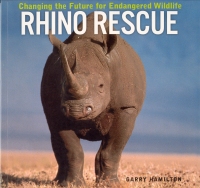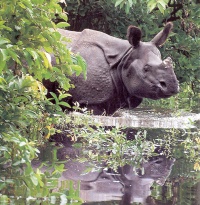| ________________
CM . . .
. Volume XII Number 18 . . . .May 12, 2006
excerpt:
Not necessarily a first choice as poster child for the animal world, the huge, homely and often bad-tempered rhino nonetheless has achieved a remarkable feat as one of the world's best conservation stories. Having no significant enemies other than humans, some species of this animal have rebounded through the aggressive efforts of conservation programs in Africa, India and Indonesia. The white rhino stands out for a reversal from a population low of a few dozen in the early 1900s to nearly 12,000 in Africa. This latest book in the “Firefly Animal Rescue” series offers a look at the rhino's remarkable history and its future. The major threats suffered by rhinos are hunting and habitat loss. The author describes various habits of the rhino, helping the reader understand the rationale behind conservation methods. Rhino horn has long been in demand as a traditional Asian medicine. The animals were often poached for the horn alone. Today, scientists are on the track of a method of identifying individual rhino horns by their chemical makeup (influenced by diet), a clue that may lead to more success in the apprehension of poachers. To mitigate the problem of decreasing habitat, ranchers are now encouraged "to combine their properties into game reserves." With eco-tourism on the rise, the incentive exists to protect a valuable resource such as the rhino which is content to remain in a small home territory as long as its specific habitat needs are met.
Each book in this series is notable for the excellent photographs that fill its pages. Readers are treated to exciting close-ups of the animals and action shots of conservationists at work worldwide. If you haven't been attracted to rhinos before, you may change your mind after seeing the appealing portrait of that new calf at the Cincinnati zoo. A list of groups devoted to rhino conservation is included for further investigation Highly Recommended. Living in BC, Gillian Richardson is a freelance writer and former teacher-librarian.
To comment
on this title or this review, send mail to cm@umanitoba.ca.
Copyright © the Manitoba Library Association. Reproduction for personal
use is permitted only if this copyright notice is maintained. Any
other reproduction is prohibited without permission.
NEXT REVIEW |
TABLE OF CONTENTS FOR THIS ISSUE
- May 12, 2006.
AUTHORS |
TITLES |
MEDIA REVIEWS |
PROFILES |
BACK ISSUES |
SEARCH |
CMARCHIVE |
HOME |

 As in other books in this series, individuals who work closely in rhino conservation efforts are profiled. These engaging accounts are peppered with quotes and are especially interesting for the degree of dedication attributed to the participants. For example, Esmond Martin "has spent 25 years trying to stop the rhino horn trade" in Asian countries and has seen a "99 percent" decline in recent years. Rob Brett has worked for 20 years moving rhinos as part of reintroduction program in southern Africa, and he sees how the transfers have become far less difficult. Readers will enjoy following the story of the small Sumatran rhino, one of the most difficult species to help with captive-breeding programs due to its shy nature. After 17 years, a successful birth was finally recorded at the Cincinnati Zoo in 2001. Read a first-hand account of the zoo director's excitement at this unique event.
As in other books in this series, individuals who work closely in rhino conservation efforts are profiled. These engaging accounts are peppered with quotes and are especially interesting for the degree of dedication attributed to the participants. For example, Esmond Martin "has spent 25 years trying to stop the rhino horn trade" in Asian countries and has seen a "99 percent" decline in recent years. Rob Brett has worked for 20 years moving rhinos as part of reintroduction program in southern Africa, and he sees how the transfers have become far less difficult. Readers will enjoy following the story of the small Sumatran rhino, one of the most difficult species to help with captive-breeding programs due to its shy nature. After 17 years, a successful birth was finally recorded at the Cincinnati Zoo in 2001. Read a first-hand account of the zoo director's excitement at this unique event.